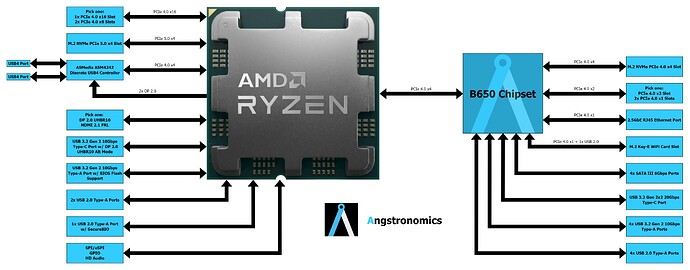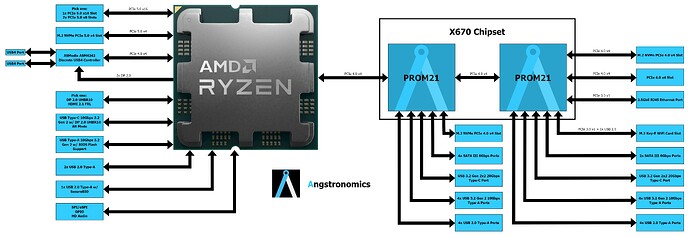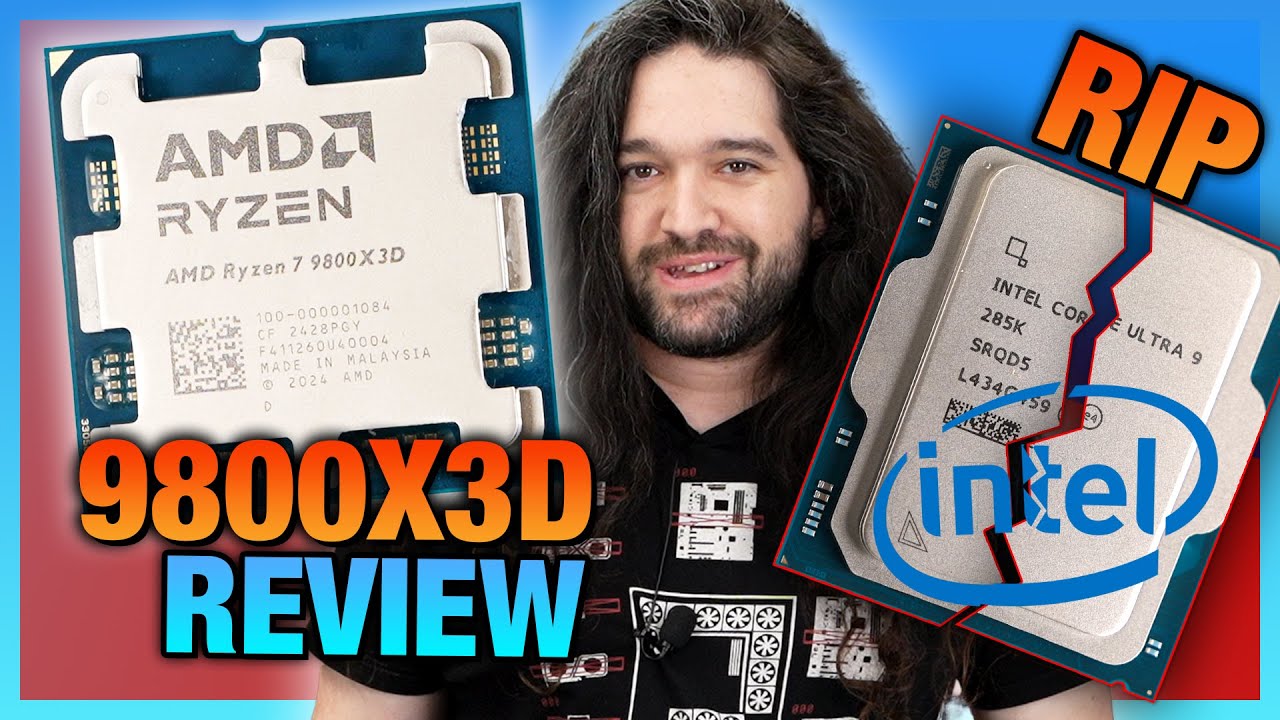I think Intel’s solution is to basically throttle the power back enough to alleviate the problem. The real solution will be the next gen of processors which I guess will be a new design.
Games don’t use all the cores - but the main issue is the architecture. On the 7950X3D only half the cores have fast access to 3D cache. So, particularly on Windows, it’s a crapshoot as to whether you get any particular bit of code running on the cores that get the full benefit of the 3D cache or on the ones that don’t.
On the 7800X3D (and presumably the 9800X3D) all of the cores have 3D cache - because all the cores are on a single chiplet.
Remember 20 years or so ago, when getting an AMD CPU was an adventure?
Compatibility issues, instabilities, etc.
Well, how the turn tables.
I witness none of that happening on todays AMD systems. They work. But Intel made their own top-liners cook themselves while attempting to keep up.
It boggles my mind to see Ryzen get 20% more FPS in Games with HALF the use of power. And I stopped accepting any peak Watt numbers as OK.
Yet market share in the private sector is all Intel. Then again every gaming console is AMD. Anyway, good times! Still having a blast with Helldivers 2. ![]()
So, about those upcoming AMD CPUs:
What’s a good site to watch in order to get good, neutral info about them?
I guess the usual hardware guys have received something like review copies to test, but are not allowed to talk about it until the presentation on the 7th?
I am really starting to get nervous about this. As I mentioned before I only do this every five years, and I have never spent that much money on a PC, so this means quite a bit of excitement for me.
Toms Hardware, Gamersnexus and hardware unboxed are my go to channels for release coverage, benchamrks etc.
So let’s manage expectations: it’s likely that 9800X3D will have a 2-10% uplift in performance, for a 10-20% uplift in real price - remember the 7800X3D street prices were held back by discounted AM4 and 5800X3D prices for most of its life and actually the price for the 7800X3D has started to come up in anticipation of the new chip!
That said, the 9800X3D will almost certainly be the best gaming CPU at any price for the next couple of years at least.
The only thing I’d say is whatever you do, don’t buy a 7800X3D right now. It is most likely to get a bit cheaper, or at worst stay the same price after the release of the 9800X3D. And that’s like a week or two away. So zen out and wait to see what it can do ![]()
I second Gamers Nexus and Hardware Unboxed. Though those two channels collude heavily and I wouldn’t expect to see wildly different numbers or recommendations from them. Jays Two Cents maybe for a less tech-heavy channel that still gives reasonable recommendations?
In the mean time, be advised that motherboard chipset names are even more weird.
B650 != B650E != B650M etc…
You want B650 or B650E. Depends on pricing and other features.
B670, B8xx are only of use in very special cases, there’s probably no reason for you to spend even 20€ more on them.
As always y’all are very helpful, thanks again!
I am trying really hard not to hop on the hype train there, and of course also trying not to spend money unnecessarily.
About the boards I had that moment when people on some hardware forum were yelling at each other because someone claimed that ALL boards were crap unless they were some special 8xx variant for a stupid amount of money (probably because that person bought one for some reason).
If you have any understanding of electrical engineering, just look at the diagrams. You will immediately understand why 670 and 8xx are not newer or faster, they just offer more of the same, and most of that will be an idle port sitting there empty.
Plus 8xx has PCIE 5, which might get relevant when you buy the predecessor of your AM5 board in 7 years.
The real question is
A) Features you need now
B) Power delivery (quality of parts)
Edit: Found pics. A 670 is two 650 daisy chained. Sacrifice 4 pcie lanes to get a couple more of them.
B650:
B670:
While I am technically an engineer, I am mainly focused on software. Hardware is not my thing.
They say you should never stop learning and challenging yourself though, so I will look into that and try to understand it. So thanks for posting it!
Just squint at it and you will see the difference immediately. Those big blue rectangles are the same chip, by the way. ![]()
About the newer boards:
B650E = B870
X670E = X870E
The only difference is that for the 800 boards it’s mandatory to have USB 4.0. That’s also possible, but optional for the 600. Wow.
So there’s really nothing new at all. Just new names. The price is the real difference.
I really like (![]() ) how AMD have shuffled the numbers so it’s not immediately clear which chipset falls in which category if you’re used to the old naming system. Still I guess they’re a tech company and all of them do it
) how AMD have shuffled the numbers so it’s not immediately clear which chipset falls in which category if you’re used to the old naming system. Still I guess they’re a tech company and all of them do it ![]()
Yeah, reminds me of when Nvidia went from 7 to 8 to 9 to 10 and instead of to 11 they went to 20, and then not to 21 but to 30.
Would be so cool if the generations were named after the year they were released, you could instantly tell which is current gen and which is older…
(Of course they would never do that)
More like when nvidia releases a 1030, but then in the next series its a 2050, then a 3050 but there’s a version that’s still called a 3050 with less and slower RAM …
(I might be getting the details wrong … but I blame that on nvidia ![]() )
)
When you realize the numbers are more the invention of the marketing dept than the engineering dept, it makes more sense.
As a general rule, each model fills a segment of the price bracket for a given amount of performance. Some generations, every model gets a big performance uplift for that same price point. In others, they move all the price points upwards in sync by 10, 15, 25% in step with the performance so you’re paying the same $/TFLOP or whatever metric you’re using.
If they suddenly switch the VRAM type/speed, or sub a cut-down higher end GPU for a full-spec lower end one without changing the price, that’s because as far as they’re concerned you’re paying the same $/TFLOP ratio as before…even if benchmarks can show a real if subtle change. Rest assured they’re doing it to increase their profit margins for one reason or another, though!
IMO the dumbest thing ever done was to offer low/midrange cards with extra VRAM so they have more than the high midrange cards while still being slower. Putting 16GB on a 3060 while the 3070 is only 8GB is just pointless. The higher range cards that COULD use more VRAM don’t get it.
Stop, you’re making me angry again! ![]()
![]()
I think the problem is that a lot of these naming games are pretty blatant attempts to get people to pay a higher tier price for what would previously have been a lower tier product, when compared to the capabilities of the current high end products.
Where’s the A820? Oh, it’s called the B840… nobody’s going to get confused about that…
And don’t get me started on the RTX 4080 12GB… actually a decent card when launched as the 4070 Ti - but that naming doesn’t make sense at all and I wouldn’t be saying it was a decent card if it was sold at 4080 prices…
My 4070 Ti Super has 16GB. So…yeah.
Yeah, I’m probably getting confused on the details again… I blame nvidia for that ![]()


